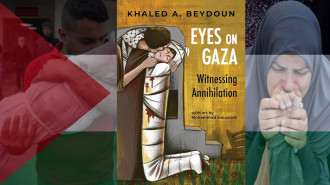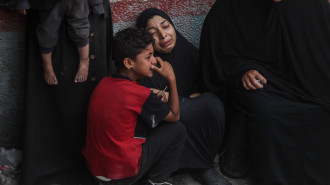
In Gaza, wearing a press vest has become a death sentence for journalists

Journalist Ismail al-Ghoul’s last words were meant to be reassuring: “The situation is very dangerous, but don’t worry,” the Gaza-based reporter for Al Jazeera told his wife, Malak Azrid, by phone. “I survived a bombing just a little while ago, thank God.”
Then, the line suddenly cut out. Despite wearing a press vest and travelling in a car marked as media, an Israeli drone strike blew the vehicle to pieces, instantly killing Ismail and his cameraman, Rami Alrifi.
Ismail’s fate demonstrates the unparalleled crisis facing journalists in Gaza, a veritable kill zone for media workers since October 7.
Of the 99 journalists who lost their lives in 2023, 72 were Palestinians who were killed in Israeli attacks, according to the Committee to Protect Journalists (CPJ).
The CPJ’s latest tally on August 9 showed that at least 113 journalists have been killed in Gaza since the conflict erupted, the most during any period since the group began keeping track in 1992.
For decades, journalists in conflict zones have donned blue vests with “PRESS” written in large, highly visible white letters. Besides providing basic protection against shrapnel, the vests are meant to send a warning sign to combatants not to fire. The deliberate attack on journalists is a war crime under international law like the Geneva Conventions.
Israel’s consistent targeting of journalists since October 7 has called this logic into question, leaving Palestinians wondering if they are putting themselves at even greater risk by identifying as media.
"Gaza is the most dangerous place in the world for journalism,” said Tahseen Al-Astal, the deputy head of the Palestinian Journalists Syndicate.
Tahseen has called Israel’s targeting of journalists “planned and systematic.” It’s meant to “eliminate them and terrorise the rest, to prevent them from telling the world the truth about the massacres happening in Gaza,” Tahseen added.
Ismail joined Al Jazeera Arabic in November 2023 as a television correspondent. He quickly became a mainstay of the network’s coverage, regularly appearing on air to report on Israel’s brutal bombardment of Gaza City, where he was based, and the worsening humanitarian crisis.
Journalists pay the price
Since October 7, more than 40,000 Palestinians have been killed and Gaza’s population of 2.3 million almost entirely displaced.
The city’s urban environment and infrastructure have been reduced to rubble, and basic necessities like food, medicine, and clean water have all but vanished.
If that wasn’t enough, Palestinian journalists who are subject to the same desperate conditions are also being killed for trying to cover them.
Throughout the war, Ismail was separated from his wife Malak, who fled with their nearly two-year-old daughter to Gaza’s south, a relatively safer zone.
Working from bombed-out Gaza City, Ismail sent them provisions of sugar and chocolate as gifts — rare delights that had dried up amid the south’s hunger crisis.
By phone, Ismail would check in on their safety and even keep up their spirits by envisioning a brighter post-war future. He told Malak that, after the war, they would buy a plot of land and build a new home atop Gaza’s rubble.
When he was killed, Malak couldn’t even bid him a last farewell, as his body was kept in the north and the Israeli army had cut off passage to the area.
“Ismail paid the price for his journalism,” Malak said. “For reporting on the Palestinian people’s suffering, he lost his life. He refused to flee to the south and insisted on continuing his journalism work.”
Kill, accuse, repeat
Israel’s tactic has been to kill journalists and then accuse them, without evidence, of working for Hamas. After the airstrike that killed Ismail, the Israeli military said he was a Hamas operative who had participated in the October 7 attack and had instructed Hamas fighters on how to record operations, an accusation that Al Jazeera has called “baseless.”
According to Malak, her husband was at home with her on October 7. “He had no connection to any group that Israel considers hostile,” she said, adding that Israel’s account of Ismail is "completely false and unrelated to reality.”
“They simply want to suppress the truth of what is happening in Gaza from reaching the world, so they try to silence any voice that speaks out about the hell of war," said Malak.
Ismail’s alleged links to Hamas seem particularly untenable given that he was previously arrested by Israeli forces and then released, an unlikely turn of events for someone wanted by the military.
In March, he was detained and beaten by Israeli forces after they raided Al-Shifa Hospital and destroyed a makeshift media operations room being used there by journalists.
In another case, Israel is levying accusations against another Al Jazeera journalist, Anas Al-Sharif, of supporting terrorism.
Following Anas' coverage of a recent attack by the Israeli military on a school, which it said targeted Hamas fighters, but killed around 100 people, the Israeli military’s Arabic-language spokesman Avichay Adrae said Anas is covering up for the militant group.
Many of Anas' colleagues fear that this is a precursor to his killing.
“The Israeli military seems to be making accusations without any substantive evidence as a license to kill journalists, which is in total contravention of international humanitarian law,” UN Special Rapporteur Irene Khan said in a statement after Ismail al-Ghoul’s death.
The Israeli military has a long history of killing journalists and getting away with it. Even before the war in Gaza, the CPJ documented at least 20 cases of journalists who were killed by Israeli Defense Forces without anyone being charged or held accountable.
The most high-profile case in recent times was that of Al Jazeera journalist Shireen Abu Akleh, who was shot in the head and killed – despite wearing her usual blue press vest – while covering a raid on a West Bank refugee camp.
A UN probe concluded that “Israeli security forces used lethal force without justification… and intentionally or recklessly violated the right to life of Shireen Abu Akleh.”
Israel’s attacks on journalists grabbed headlines again just after October 7, when an Israeli tank strike killed Reuters journalist Issam Abdullah and wounded six others in southern Lebanon, despite the group being clearly identifiable as journalists, according to a UN investigation.
'Israel wants to eliminate every voice coming from Gaza'
"Even in light of this bloody history, what’s happened in Gaza over the past ten months marks a huge escalation," said veteran Al Jazeera correspondent in Gaza, Hisham Zaqout.
It’s not simply that Israel is ignoring long-held conventions about avoiding areas where journalists are present, but instead, they are actively “justifying the bloodshed of Palestinian journalists… by claiming they are part of the battle,” explained Hisham.
Since Ismail’s murder, two more journalists were killed: Ebhrahim Mohareb who was on a reporting assignment with several other journalists covering Israeli incursions in Khan Younis when killed by Israeli gunpowder, and Hamza Mortaji, who was killed in a raid on a school hosting displaced people in Gaza City.
Besides directly targeting journalists, Israel has also made it less safe and more difficult to do the work, said Hisham. He pointed out that they have cut the internet, blocked entry to protective equipment like helmets and vests, and confiscated electronics like cameras and “anything related to journalistic work.”
“Israel wants to eliminate every voice coming from Gaza that exposes the crimes and massacres committed against Palestinians. To do that, they prevent foreign journalists from entering, block our coverage in areas that they invade, and even target us directly,” Hisham added.
“Our lives and the lives of our families are being lost. Our offices, equipment, and homes are being destroyed,” said Hisham.
The latest media worker turned victim was Tamin Muammar, a journalist with the Palestinian Authority’s Public Radio and Television. An Israeli airstrike hit his home in Khan Younis, also killing his wife and their three young daughters.
"Despite the horrors that journalists endure here, they insist on continuing their work as it is both a professional, ethical, national, and humanitarian duty," said Tahseen.
“If others experienced even a fraction of what they go through, they would abandon their positions and leave."
Mohamed Solaimane is a Gaza-based journalist with bylines in regional and international outlets, focusing on humanitarian and environmental issues
This piece was published in collaboration with Egab






 Follow the Middle East's top stories in English at The New Arab on Google News
Follow the Middle East's top stories in English at The New Arab on Google News


